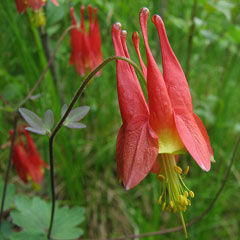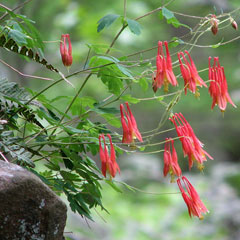 |
|
http://commons.wikimedia.org/wiki/User:Ragesoss |
 |
| http://commons.wikimedia.org/wiki/User:Ragesoss |
Translate this page:
Summary
Bloom Color: Red, Yellow.
Main Bloom Time: Late spring, Mid spring. Form: Irregular or sprawling.
Physical Characteristics

 Aquilegia canadensis is a PERENNIAL growing to 0.6 m (2ft) by 0.3 m (1ft in) at a medium rate.
Aquilegia canadensis is a PERENNIAL growing to 0.6 m (2ft) by 0.3 m (1ft in) at a medium rate.
See above for USDA hardiness. It is hardy to UK zone 3 and is not frost tender. It is in flower from May to July. The species is hermaphrodite (has both male and female organs) and is pollinated by Bees. The plant is self-fertile.
Suitable for: light (sandy) and medium (loamy) soils, prefers well-drained soil and can grow in nutritionally poor soil. Suitable pH: mildly acid, neutral and basic (mildly alkaline) soils. It can grow in semi-shade (light woodland) or no shade. It prefers moist soil.
UK Hardiness Map
US Hardiness Map
Synonyms
Plant Habitats
Woodland Garden Dappled Shade; Shady Edge;
Edible Uses
Edible Parts: Flowers Root
Edible Uses:
Flowers - raw. Sweet and delightful[172]. Rich in nectar[213], they make a very attractive addition to mixed salads and can also be used as a thirst-quenching munch in the garden[K]. Root[2, 105, 177]. These reports possibly refer to the root being chewed for its medicinal virtues[K]. Caution is advised, see notes above on toxicity[172].
References More on Edible Uses
Medicinal Uses
Plants For A Future can not take any responsibility for any adverse effects from the use of plants. Always seek advice from a professional before using a plant medicinally.
Anodyne Antispasmodic Astringent Diaphoretic Diuretic Febrifuge Parasiticide Parasiticide
Resolvent Salve
Antispasmodic, diaphoretic, parasiticide, resolvent, salve[172, 222]. The root is astringent and diuretic[222, 257]. It is chewed or made into a weak tea for the treatment of diarrhoea and stomach aches[222]. The tea is used in the treatment of uterine bleeding[222]. The boiled plant was used as a hair wash[213]. The seed is anodyne and febrifuge[257]. An infusion is used in the treatment of headaches and fevers[257].
References More on Medicinal Uses
The Bookshop: Edible Plant Books
Our Latest books on Perennial Plants For Food Forests and Permaculture Gardens in paperback or digital formats.

Edible Tropical Plants
Food Forest Plants for Hotter Conditions: 250+ Plants For Tropical Food Forests & Permaculture Gardens.
More

Edible Temperate Plants
Plants for Your Food Forest: 500 Plants for Temperate Food Forests & Permaculture Gardens.
More

More Books
PFAF have eight books available in paperback and digital formats. Browse the shop for more information.
Shop Now
Other Uses
References More on Other Uses
Cultivation details
Landscape Uses:Alpine garden, Container, Foundation, Massing, Rock garden, Woodland garden. An easily grown and very tolerant plant[K], it succeeds in ordinary garden soil, preferring a moist but not wet soil and a sunny position[1]. Intolerant of heavy clay[200]. Does well in semi-shade[111]. Prefers a rather poor slightly acid soil[111]. A very ornamental and cold-hardy plant, it tolerates temperatures down to about -25°c[1,187]. Plants seem to be immune to the predations of rabbits[233]. A greedy plant inhibiting the growth of nearby plants, especially legumes[54]. Plants are pollinated by humming birds in the wild[187]. Most species in this genus are short-lived, dying out after 2 - 3 years, though they usually produce seed prolifically[200]. However, they are very apt to hybridize with other members of the genus and so it becomes difficult to keep a species true to type if more than one is grown in the garden[200]. Special Features:Attracts birds, North American native, Naturalizing, Wetlands plant, Attracts butterflies, Suitable for cut flowers. The plant is heat tolerant in zones 8 through 1. (Plant Hardiness Zones show how well plants withstand cold winter temperatures.
Plant Heat Zones show when plants would start suffering from the heat.
The Plant Heat Zone map is based on the number of "heat days" experienced in a given area where the temperature climbs to over 86 degrees F (30°C).
At this temperature, many plants begin to suffer physiological damage. Heat Zones range from 1 (no heat days) to 12 (210 or more heat days).
For example Heat Zone. 11-1 indicates that the plant is heat tolerant in zones 11 through 1.) For polyculture design as well as the above-ground architecture (form - tree, shrub etc. and size shown above) information on the habit and root pattern is also useful and given here if available. The plant growth habit is a clumper with limited spread [1-2]. The root pattern is a tap root similar to a carrot going directly down [1-2].
References Carbon Farming Information and Carbon Sequestration Information
Temperature Converter
Type a value in the Celsius field to convert the value to Fahrenheit:
Fahrenheit:
The PFAF Bookshop
Plants For A Future have a number of books available in paperback and digital form. Book titles include Edible Plants, Edible Perennials, Edible Trees,Edible Shrubs, Woodland Gardening, and Temperate Food Forest Plants. Our new book is Food Forest Plants For Hotter Conditions (Tropical and Sub-Tropical).
Shop Now
Plant Propagation
Seed - best sown as soon as it is ripe in a cold frame. The seed can be slow to germinate[200]. Stored seed can be sown in late winter in a cold frame. When large enough to handle, prick the seedlings out into individual pots and grow them on in a cold frame for their first winter. Plant out in late spring or early summer. Division in spring[200].
Other Names
If available other names are mentioned here
Native Range
NORTHERN AMERICA: Canada, Yukon, United States, Alaska, Québec, Nova Scotia, Ontario, Newfoundland and Labrador, Manitoba, British Columbia, United States, Connecticut, Indiana, Massachusetts, Michigan, New Hampshire, New Jersey, New York, Ohio, Pennsylvania, Rhode Island, Vermont, West Virginia, Illinois, Iowa, Kansas, Minnesota, Missouri, Nebraska, North Dakota, Oklahoma, South Dakota, Wisconsin, Alabama, Arkansas, Delaware, Florida, Georgia, Kentucky, Maryland, North Carolina, South Carolina, Tennessee, Virginia, Texas,
Weed Potential
Right plant wrong place. We are currently updating this section.
Please note that a plant may be invasive in one area but may not in your area so it's worth checking.
Conservation Status
IUCN Red List of Threatened Plants Status :

Growth: S = slow M = medium F = fast. Soil: L = light (sandy) M = medium H = heavy (clay). pH: A = acid N = neutral B = basic (alkaline). Shade: F = full shade S = semi-shade N = no shade. Moisture: D = dry M = Moist We = wet Wa = water.
Now available:
Food Forest Plants for Mediterranean Conditions
350+ Perennial Plants For Mediterranean and Drier Food Forests and Permaculture Gardens.
[Paperback and eBook]
This is the third in Plants For A Future's series of plant guides for food forests tailored to
specific climate zones. Following volumes on temperate and tropical ecosystems, this book focuses
on species suited to Mediterranean conditions—regions with hot, dry summers and cool, wet winters,
often facing the added challenge of climate change.
Read More
Expert comment
Author
L.
Botanical References
43200
Links / References
For a list of references used on this page please go here
Readers comment
| Add a comment |
|
If you have important information about this plant that may help other users please add a comment or link below. Only comments or links that are felt to be directly relevant to a plant will be included. If you think a comment/link or information contained on this page is inaccurate or misleading we would welcome your feedback at [email protected]. If you have questions about a plant please use the Forum on this website as we do not have the resources to answer questions ourselves.
* Please note: the comments by website users are not necessarily those held by PFAF and may give misleading or inaccurate information.
To leave a comment please Register or login here All comments need to be approved so will not appear immediately.
|
Subject : Aquilegia canadensis
|
|
|
|